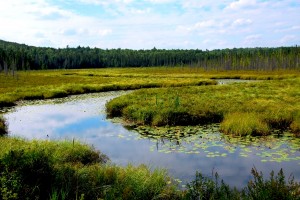 A new Environmental Protection Agency (EPA) rule could have a big impact on wetlands permitting, changing the way streams and wetlands are regulated under the Clean Water Act. Recent Supreme Court cases have created confusion when attempting to determine which “waters of the U.S.” require permits for filling or dredging activities, and there’s more to come in this debate before a final resolution is reached.
A new Environmental Protection Agency (EPA) rule could have a big impact on wetlands permitting, changing the way streams and wetlands are regulated under the Clean Water Act. Recent Supreme Court cases have created confusion when attempting to determine which “waters of the U.S.” require permits for filling or dredging activities, and there’s more to come in this debate before a final resolution is reached.
In an attempt to define what constitutes a water of the US, the EPA recently released a draft report “Connectivity of Streams and Wetlands to Downstream Waters: A Review and Synthesis of Scientific Evidence.” A short time later, a proposed regulatory rule, based on this draft Connectivity Report was released. The new rule could expand the regulatory jurisdiction that the EPA and the U.S. Army Corps of Engineers have over navigable waters. Although the report and rule are still in draft form, these new rules could mean big changes for wetlands permitting. The connectivity to traditionally navigable waters would potentially be extended to include previously nonjurisdictional waters, such as ephemeral drainages, private ponds and lakes, and higher order streams.
Why It Matters
Under Section 404 of the Clean Water Act, landowners are required to obtain wetland permits prior to filling or otherwise impacting wetlands or other “waters of the U.S.” Defining what constitutes “waters of the U.S.” has been topic of contention in recent years, with the 2006 Rapanos v. United States Supreme Court split decision causing a considerable amount of confusion. The connectivity report attempts to distill vast amounts of scientific research (over 1,000 pieces of scientific literature) into a single report with the objective of clearly defining what is and is not a “water of the U.S.” The public comments received on the draft of this report were numerous.
Many questioned the proposed rules and the way the EPA has handled the draft process. For example, the agency released the draft regulatory rule change to the Office of Management and Budget before taking into consideration feedback from the public comment period for the scientific document. The Water Advocacy Coalition said the EPA “put the cart before the horse,” and asked the agency to withdraw the draft rule and wait to make any regulatory decisions until the final scientific review is complete.
It’s likely that when this rule takes effect, anticipated in Spring 2014, it will throw permitting into a tailspin while the U.S. Army Corps of Engineers interprets and applies the new rules when issuing wetland permits. This discovery phase means that permits will likely be delayed, similar to what was experienced following the Rapanos v. United States ruling.
What You Can Do
Since the future of the wetlands regulatory climate is uncertain, it would be prudent to obtain any necessary permits now for foreseeable projects over the next couple of years before the waters get muddy — pun intended.
The final version of the scientific document should be released in Spring 2014, but if you want to learn more about what these regulations could mean to you or your project, I’d love to talk with you about that. You can connect with me through the comment section here, send me an email at ssoard@burnsmcd.com, or give me a call at 816-822-4330. Also, if we’re not yet connected on LinkedIn, don’t hesitate to connect with me there — here’s a link to my profile.
Sarah Soard heads up the Environmental Permitting department at Burns & McDonnell. She is a certified Professional Wetland Scientist and is specialized in wetland monitoring and the design and creation of wetlands as mitigation sites. If you would like more information, feel free to connect with Sarah on Linkedin.
